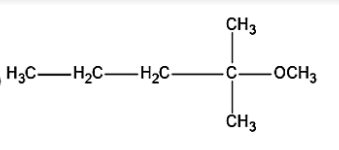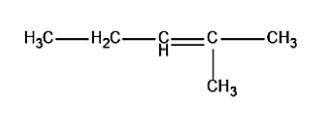Answer
36.9k+ views
Hint: When 2-Chloro-2-methylbutane reacts with sodium methoxide in methanol, it undergoes \[{S_N}1\] and \[{E_1}\]. \[{S_N}1\]means unimolecular nucleophilic substitution reaction and \[{E_1}\]means unimolecular elimination reaction. On knowing what type of reaction can take place in this \[{S_N}1\]and \[{E_1}\]mechanism we can determine the product.
Complete step by step answer:
2-Chloro-2-methylbutane when reacted with sodium methoxide in methanol, it will form a carbocation by the removal of \[NaCl\]. The formed carbocation will undergo \[{S_N}1\] and \[{E_1}\].
In \[{S_N}1\]mechanism, nucleophile will come and attack the same position of the leaving group, that means that the nucleophile, methoxy group \[C{H_3}{O^ - }\] will be attached in the position of the leaving chlorine \[C{l^ - }\] group. Thus, leading to the formation of 2-Methoxy-2-methylbutane i.e. compound (a) in the figure.
In the\[{E_1}\] mechanism, the deprotonation will occur in the carbon atom which is nearer to the carbocation and hence leading to the formation of alkene. In 2-methylbutane carbocation, there are two carbon atoms which are nearer to the carbocation. One carbon atom is at the terminal position and the other carbon atom is at the third position.
In the terminal carbon atom, a proton is removed, thus leading to the formation of 2-methyl-1-butene i.e. compound (b) in the figure.
In the third carbon atom, a proton will be removed, thus leading to the formation of 2-methyl-2-butene i.e. compound (c) in the figure.
Therefore, all the three compounds(a), (b) and (c) during the reaction of 2-Chloro-2-methylbutane with sodium methoxide in methanol.
Hence, the correct answer is option (A) all the above.
Additional information:
Comparison of \[{S_N}1\] and \[{S_N}2\]
Note: In the reaction both elimination and substitution reaction take place. In the elimination reaction the deprotonation of the carbocation takes places to form alkene, while in the substitution reaction, substitution of leaving group by a nucleophile takes place. Here substitution takes place at only one position while elimination is taking place at two positions.
Complete step by step answer:
2-Chloro-2-methylbutane when reacted with sodium methoxide in methanol, it will form a carbocation by the removal of \[NaCl\]. The formed carbocation will undergo \[{S_N}1\] and \[{E_1}\].
In \[{S_N}1\]mechanism, nucleophile will come and attack the same position of the leaving group, that means that the nucleophile, methoxy group \[C{H_3}{O^ - }\] will be attached in the position of the leaving chlorine \[C{l^ - }\] group. Thus, leading to the formation of 2-Methoxy-2-methylbutane i.e. compound (a) in the figure.
In the\[{E_1}\] mechanism, the deprotonation will occur in the carbon atom which is nearer to the carbocation and hence leading to the formation of alkene. In 2-methylbutane carbocation, there are two carbon atoms which are nearer to the carbocation. One carbon atom is at the terminal position and the other carbon atom is at the third position.
In the terminal carbon atom, a proton is removed, thus leading to the formation of 2-methyl-1-butene i.e. compound (b) in the figure.
In the third carbon atom, a proton will be removed, thus leading to the formation of 2-methyl-2-butene i.e. compound (c) in the figure.
Therefore, all the three compounds(a), (b) and (c) during the reaction of 2-Chloro-2-methylbutane with sodium methoxide in methanol.
Hence, the correct answer is option (A) all the above.
Additional information:
Comparison of \[{S_N}1\] and \[{S_N}2\]
| \[{S_N}1\] | \[{S_N}2\] |
| Unimolecular | Bimolecular |
| Rate depends on two species | Rate depends only on one species |
| Second order | First order |
| Solvent used is polar protic | Solvent used is Polar aprotic |
| Alkyl halide reacts in the order\[3^\circ > 2^\circ > 1^\circ \] | Alkyl halide reacts in the order\[1^\circ > 2^\circ > 3^\circ \] |
Note: In the reaction both elimination and substitution reaction take place. In the elimination reaction the deprotonation of the carbocation takes places to form alkene, while in the substitution reaction, substitution of leaving group by a nucleophile takes place. Here substitution takes place at only one position while elimination is taking place at two positions.
Recently Updated Pages
If a wire of resistance R is stretched to double of class 12 physics JEE_Main

The path difference between two waves for constructive class 11 physics JEE_MAIN

What is the difference between solvation and hydra class 11 chemistry JEE_Main

IfFxdfrac1x2intlimits4xleft 4t22Ft rightdt then F4-class-12-maths-JEE_Main

Sodium chloride is purified by passing hydrogen chloride class 11 chemistry JEE_Main

Hydrogen readily combines with nonmetals and thus it class 12 chemistry JEE_Main

Other Pages
An electric bulb has a power of 500W Express it in class 11 physics JEE_Main

The cell in the circuit shown in the figure is ideal class 12 physics JEE_Main

Explain the construction and working of a GeigerMuller class 12 physics JEE_Main

For an electromagnet the core should have A High retentivity class 12 physics JEE_Main

Dissolving 120g of urea molwt60 in 1000g of water gave class 11 chemistry JEE_Main

Normality of 03 M phosphorus acid H3PO3 is A 05 B 06 class 11 chemistry JEE_Main






